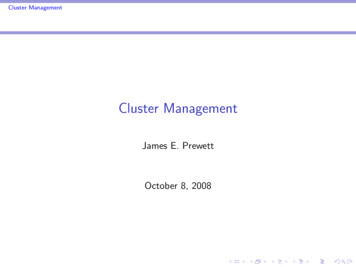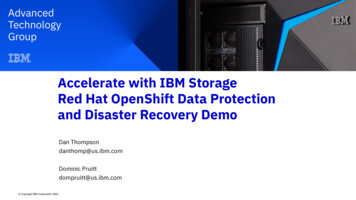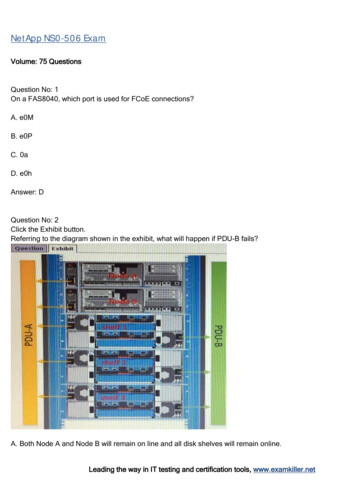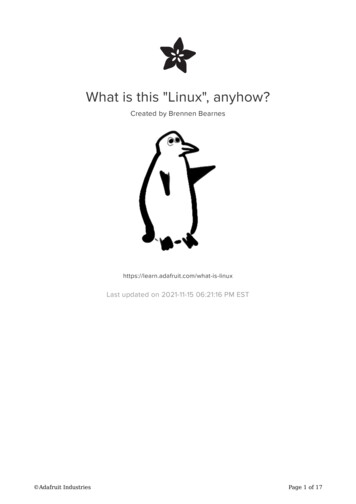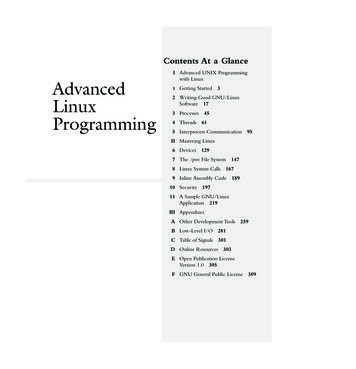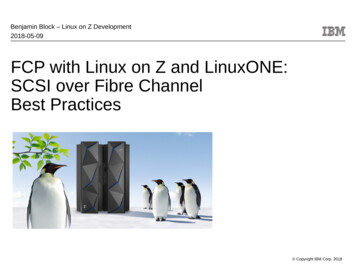
Transcription
Benjamin Block – Linux on Z Development2018-05-09FCP with Linux on Z and LinuxONE:SCSI over Fibre ChannelBest Practices Copyright IBM Corp. 2018
FCP with Linux on Z and LinuxONE: SCSI over Fibre Channel Best PracticesTrademarksThe following are trademarks of the International Business Machines Corporation in the United States, other countries, or both.Not all common law marks used by IBM are listed on this page. Because of the large number of products marketed by IBM, IBM's practice is to list only the most important of its common lawmarks. Failure of a mark to appear on this page does not mean that IBM does not use the mark nor does it mean that the product is not actively marketed or is not significant within itsrelevant market.IBM, the IBM logo, and ibm.com are trademarks or registered trademarks of International Business Machines Corp., registered in many jurisdictions worldwide. Otherproduct and service names might be trademarks of IBM or other companies.A current list of IBM trademarks is available on the Web at: http://www.ibm.com/legal/copytrade.shtml.Those trademarks followed by are registered trademarks of IBM in the United States; those followed by are trademarks or common law marks of IBM in the United States.*, AIX , AS/400e , Db2 , DB2 , developerWorks , DS8000 , ECKD , eServer , FICON , GPFS , HiperSockets , HyperSwap , IBM , IBM (logo) , IBM FlashSystem , IBMLinuxONE , IBM LinuxONE Emperor , IBM LinuxONE Emperor II , IBM LinuxONE Rockhopper , IBM Spectrum , IBM Spectrum Control , IBM Spectrum Storage , IBM Z , IBM zSystems , IBM z13 , IBM z13s , IBM z14 , ibm.com , Linear Tape File System , OS/390 , PR/SM , RS/6000 , Redbooks , Redpaper , Redpapers , S390-Tools , S/390 ,Storwize , Storwize (logo) , System Storage , System Storage DS , System z , System z9 , System z10 , System/390 , Tivoli , Tivoli (logo) , XIV , z Systems , z9 , z10 , z13 ,z13s , z/Architecture , z/OS , z/VM , z/VSE , zEnterprise * All other products may be trademarks or registered trademarks of their respective companies.The following are trademarks or registered trademarks of other companies.Adobe, the Adobe logo, PostScript, and the PostScript logo are either registered trademarks or trademarks of Adobe Systems Incorporated in the United States, and/or other countries.IT Infrastructure Library is a Registered Trade Mark of AXELOS Limited.ITIL is a Registered Trade Mark of AXELOS Limited.Linear Tape-Open, LTO, the LTO Logo, Ultrium and the Ultrium Logo are registered trademarks of Hewlett Packard Enterprise, International Business Machines Corporation and Quantum Corporation in the United Statesand other countries.Intel, Intel logo, Intel Inside, Intel Inside logo, Intel Centrino, Intel Centrino logo, Celeron, Intel Xeon, Intel SpeedStep, Itanium, and Pentium are trademarks or registered trademarks of Intel Corporation or its subsidiaries inthe United States and other countries.Linux is a registered trademark of Linus Torvalds in the United States, other countries, or both.Microsoft, Windows, Windows NT, and the Windows logo are trademarks of Microsoft Corporation in the United States, other countries, or both.Java and all Java-based trademarks and logos are trademarks or registered trademarks of Oracle and/or its affiliates.Cell Broadband Engine is a trademark of Sony Computer Entertainment, Inc. in the United States, other countries, or both and is used under license therefrom.UNIX is a registered trademark of The Open Group in the United States and other countries.VMware, the VMware logo, VMware Cloud Foundation, VMware Cloud Foundation Service, VMware vCenter Server, and VMware vSphere are registered trademarks or trademarks of VMware, Inc. or its subsidiaries in theUnited States and/or other jurisdictions.Notes:Performance is in Internal Throughput Rate (ITR) ratio based on measurements and projections using standard IBM benchmarks in a controlled environment. The actual throughput that any user willexperience will vary depending upon considerations such as the amount of multiprogramming in the user's job stream, the I/O configuration, the storage configuration, and the workload processed. Therefore,no assurance can be given that an individual user will achieve throughput improvements equivalent to the performance ratios stated here.IBM hardware products are manufactured from new parts, or new and serviceable used parts. Regardless, our warranty terms apply.All customer examples cited or described in this presentation are presented as illustrations of the manner in which some customers have used IBM products and the results they may have achieved. Actualenvironmental costs and performance characteristics will vary depending on individual customer configurations and conditions.This publication was produced in the United States. IBM may not offer the products, services or features discussed in this document in other countries, and the information may be subject to change withoutnotice. Consult your local IBM business contact for information on the product or services available in your area.All statements regarding IBM's future direction and intent are subject to change or withdrawal without notice, and represent goals and objectives only.Information about non-IBM products is obtained from the manufacturers of those products or their published announcements. IBM has not tested those products and cannot confirm the performance,compatibility, or any other claims related to non-IBM products. Questions on the capabilities of non-IBM products should be addressed to the suppliers of those products.Prices subject to change without notice. Contact your IBM representative or Business Partner for the most current pricing in your geography.2 Copyright IBM Corp. 2018
FCP with Linux on Z and LinuxONE: SCSI over Fibre Channel Best PracticesAgenda Introduction and Terminology Setup– I/O Configuration– Multipathing– LUN Management with ZFCP IPL (booting) over FCP3 Copyright IBM Corp. 2018
FCP with Linux on Z and LinuxONE: SCSI over Fibre Channel Best PracticesIntroduction and Terminology4 Copyright IBM Corp. 2018
FCP with Linux on Z and LinuxONE: SCSI over Fibre Channel Best PracticesFCP in a nutshell Storage Area Networks (SANs) are specialized networks dedicated to thetransport of mass storage data (block/object oriented) Today the most common SAN technology used is Fibre Channel (FC) [T11] The Fibre Channel standard was developed by the InterNational Committee forInformation Technology Standards (INCITS) Over this FC transport, using the Fibre Channel Protocol (FCP) as encapsulation,the SCSI protocol is used to address and transfer raw data between server andstorage device [T10] Each server and storage is equipped with a least two adapters which provide aredundant physical connection to a redundant SAN For Z or LinuxONE, any supported FCP adapter, such as FICON Express, can beused for this purpose.– Latest adapter card is:FICON Express16S Throughout presentation, all royal bluetext fragments are clickable hyperlinks!5 Copyright IBM Corp. 2018
FCP with Linux on Z and LinuxONE: SCSI over Fibre Channel Best PracticesSAN Topologies and IBM Z / LinuxONEdirect attachedarbitrated loop [T11 FC-AL]point-to-pointfocusswitched fabricDiskDisk[T11 FC-SW]notsupportedDisk6Tape Copyright IBM Corp. 2018TapeTape
FCP with Linux on Z and LinuxONE: SCSI over Fibre Channel Best PracticesFCP with IBM Z / LinuxONEZ system with s / virtual machinesdevnoFCP device in Linux: /sys/devices/css0/0.3.001f/0.3.5a00subchannel setsubchannel bus-IDdevice bus-IDFCP devices (direct-attached) / virtual HBAsFCP subchannelsCHPIDs (1 per PCHID if spanned), type FCPPCHIDs / FCP Channels / HBAs (2 per card)FICON Express16S cardsinitiator physical fibre ports (2 per card)SANfabric 1SANfabric 2paths over physically redundant FC fabricstarget physical fibre portsstorage target7 Copyright IBM Corp. 2018I/O Configur.(IOCDS)
FCP with Linux on Z and LinuxONE: SCSI over Fibre Channel Best PracticesSAN Addressing for One (of Multiple) PathsFCP device(”virtual Adapter”)e.g. 0.3.5a008 Copyright IBM Corp. 2018targetWorldwide Port Name(WWPN)e.g. 0x5005076303000104Logical Unit Number(LUN)e.g. 0x4021403f00000000
FCP with Linux on Z and LinuxONE: SCSI over Fibre Channel Best PracticesLinux kernel parameters and zipl target kernel parameters– RHEL, SLES 11, Ubuntu [doc]1.edit variable 'parameters' in /etc/zipl.conf2.if changes affect root file system dependencies, run onRHEL 5, SLES 11: mkinitrd ; RHEL 6: dracut -f ; Ubuntu: update-initramfs -u3.run [optional with Ubuntu, otherwise mandatory]: /sbin/zipl– SLES12 [doc]: no zipl.conf ; use 'yast bootloader' or:1.edit variable 'GRUB CMDLINE LINUX DEFAULT' in /etc/default/grub2.if changes affect root file system dependencies, run: dracut -f && grub2-install3.run: grub2-mkconfig -o /boot/grub2/grub.cfg– For dynamic mechanism, seeslide SCSI IPL Dynamically Pass Kernel Parameters– RHEL, SLES 11, Ubuntu [doc]/boot/manually maintained by administrator– SLES12 [doc]/boot/zipl/ automatically maintained (do not touch) by grub2 toolchain9 Copyright IBM Corp. 2018
FCP with Linux on Z and LinuxONE: SCSI over Fibre Channel Best PracticesSetup10 Copyright IBM Corp. 2018
FCP with Linux on Z and LinuxONE: SCSI over Fibre Channel Best PracticesSetup Overview for FCP with Linux on Z and LinuxONE1) Optionally: Early Preparation.2) Define FCP devices within the mainframe (I/O Configuration), dedicate in z/VM.3) Enable NPIV for the FCP devices (Service Element / HMC).4) Configure zoning for the FCP devices to gain access to desired target portswithin a SAN, max. one single initiator (virtual) WWPN per zone.5) Configure LUN masking for the FCP devices at the target deviceto gain access to desired LUNs.6) In Linux, configure multipathing7) In Linux, configure target WWPNs and LUNs to obtain SCSI devices.Note I: If FCP Channel is directly connected to a target device (point-to-point), steps 3 & 4 do not apply.After preparation, steps 4 & 5 can be conducted before or in parallel to step 3.Note II: For steps 2, 3, 4 and 5 there are additional slides in the ‘Additional Slides’ part of the presentation.11 Copyright IBM Corp. 2018
FCP with Linux on Z and LinuxONE: SCSI over Fibre Channel Best PracticesI/O Configuration for FCP Devices for LPAR hypervisor (PR/SM): use Dynamic Partition Manager (DPM) [doc][z13 GA2],or explicit virtual device config & passthrough in IOCDS for z/VM: dedicate 1 NPIV FCP device per CHPID per z/VM guest in its user dir. for KVM on IBM Z: on host, use 1 NPIV FCP device per CHPID per KVM guest Use N Port ID Virtualization (NPIV) whenever possible We recommend the use of strict Single Initiator Zoning in the SAN12 Copyright IBM Corp. 2018
FCP with Linux on Z and LinuxONE: SCSI over Fibre Channel Best PracticesZ / LinuxONE Hardware for FCP: Limits per Channel (PCHID)Z system with PR/SMLPAR1LinuxLPAR2z/VMVM1LinuxVM2Linuxassuming one online FCP device per VM per PCHIDV: # of VMs per PCHIDP: # of target ports per NPIV-enabled FCP deviceL: # of LUNs per target portassuming equal distribution of resources:V 64(32) && V (P 1) 1000(500) && V P L 8192(4096)FCP devices (direct-attached) / virtual HBAs: 64(32) online NPIV-enabled FCP devices per PCHID Linux 255 defined FCP devices per LPAR per CHPID IOCDS 480 defined FCP devices per CHPID IOCDSPCHID / FCP Channel / HBASANfabric 1plus 2·4green linesplus 2·4blue lines13SANfabric 2(dark magenta values in parentheses areold limits with adapters older than FICON Express16S &16S )2 red 2 green 1000(500) open target ports per PCHID zoning2 blueaccount for 1 zfcp-internal nameserver port per FCP device! 8192(4096) attached LUNs per PCHID LUN masking & zoning Copyright IBM Corp. 2018
FCP with Linux on Z and LinuxONE: SCSI over Fibre Channel Best PracticesMultipathingLinuxLinux 2 disjoint paths from OS to target device (disk,tape, );independent FCP cards, independent switches, and independent target ports.– Redundancy: Avoid single points of failure– Performance: I/O requests can be spread across multiple paths– Serviceability: When component of one path is in maintenance modeI/O continues to run through other path(s) Linux does multipathing differently for disks and tapes 14 Copyright IBM Corp. 2018
FCP with Linux on Z and LinuxONE: SCSI over Fibre Channel Best PracticesMultipathing for Disks – Persistent Configuration Use multipathing on installation for all disks incl. root-fs and zipl target:SLES,RHEL 6,KVM,UbuntuLifting single path to multipath is difficult [ S10, R6,U].– zipl target: use multipathing with sep. mountpoint, or place inside root-fs[S10.4,S11.1,R6,K,U],if stacking devices on top of multipathing see zipl helper.device-mapper docs– Root-fs (/): always multipathing (optionally stack devices on top)– any other mountpoint or direct access block device: always multipathing(optionally any other virtual block devices such as LVM on top) Post installation [SLES, RHEL, KVM, Ubuntu]:– ensure /etc/multipath.conf is suitable (esp. blacklist)– ensure multipathd is enabled and running (re-activates failed paths)(NOTE: option rr min io is called rr min io rq in more recent distros)15 Copyright IBM Corp. 2018
FCP with Linux on Z and LinuxONE: SCSI over Fibre Channel Best PracticesMultipathing for Disks – device-mapper multipath devices device-mapper multipath target in kernel creates one block device per unique WWID;“user friendly names no”In /etc/multipath.confdm multipath/dev/sda/dev/sdbLinux SCSI layer, zfcpFCP adapter 116 Copyright IBM Corp. 2018FCP adapter 2 World-Wide Identifier (not LUN!)from storage server identifiesvolume / disk / path group each SCSI device represents asingle path to a target device,do not use these devices directly!
FCP with Linux on Z and LinuxONE: SCSI over Fibre Channel Best PracticesMultipathing for Disks – device-mapper multipath devices (cont.) Multipath devices are created automatically when SCSI LUNs are attachedWWID forvolumepathgroup# multipathd -k'show topo'36005076303ffc5620000000000002006 dm-0 IBM,2107900size 5.0G features '1 queue if no path' hwhandler '0' wp rw - - policy 'service-time 0' prio 1 status active - 0:0:2:1074151456 sda8:0active ready running - 1:0:5:1074151456 sdb8:16 active ready running Multipath devices are virtual block devices, can be used as container for, e.g.– Partitions– Logical Volume Manager (LVM): more details– Other Device-Mapper Targets: e.g. DM-Crypt for encryption of data in flight and at rest– Directly for a file system or as raw block device (e.g. for RDBMS) Device to work with: e.g. /dev/mapper/36005076303ffc5620000000000002006(or user-friendly / alias multipath names such as /dev/mapper/mpatha if enabled)# mkfs.ext4 /dev/mapper/36005076303ffc5620000000000002006# mount /dev/mapper/36005076303ffc5620000000000002006 /mnt17 Copyright IBM Corp. 2018
FCP with Linux on Z and LinuxONE: SCSI over Fibre Channel Best PracticesMultipathing – Error Recovery on FC Transport Layer on zfcp detecting broken target port (cable pull, switch maint., target logged out):tell FC transport class, which starts fast io fail tmo & dev loss tmo for rport on fast io fail tmo: zfcp port recovery returns pending IO with result (on dev loss tmo: zfcp port recovery returns pending IO with resultand FC transport deletes SCSI target with its SCSI devices) issues under IO disable dev loss tmo and enable fast io fail tmo (5 seconds):– for disks: “infinity” or “2147483647” for dev loss tmo in .CONF(5)]– for devices not handled by dm multipath/multipath-tools (e.g.: tapes, libraries, ): refer to the respective manual, or if not specified, stay with the defaultvalues– double check with “lszfcp -Pa” path failover: kernel dm multipath can re-queue returned IO on another pathDID TRANSPORT FAILFASTDID NO CONNECT18 Copyright IBM Corp. 2018
FCP with Linux on Z and LinuxONE: SCSI over Fibre Channel Best PracticesMultipathing – Handling on Losing Last Path if all paths gone at the same time (even for a split second),return I/O error (clusters and/or cluster applications) or queue I/O (other):disks: /etc/multipath.conf: 'no path retry queue' (alias feature queue if no path);multipath.conf settings can contradict double check if queueing is active:# multipathd -k'list maps status'namefailback queueing paths dm-st write prot36005076802870052a000000000000318 immediate on2active rw36005076304ffc3e80000000000002000 on2active rwotherwise data corruption can occur if applications don't handle I/O errors correctly above setting required for z/VM SSI live guest relocation (LGR)with dedicated FCP devices [z/VM docs1, docs2] if I/O is stuck due to queueing and paths won't return but you want to flush I/O:# dmsetup message mapname 0 fail if no path [SLES,RHEL,KVM,Ubuntu] do not queue for: Linux software storage site mirroring for disaster recovery19 Copyright IBM Corp. 2018
FCP with Linux on Z and LinuxONE: SCSI over Fibre Channel Best PracticesLUN Management with ZFCP: 2 Methods1) automatic LUN scanning (new and only with NPIV-enabled FCP devices)– user specifies to only set FCP device online– zfcp attaches all paths visible through fabric zoning and target LUN masking2) explicit manual LUN whitelist (traditional)– user specifies every single path using FCP device,WWPN,FCP LUN – zfcp only attaches these paths to ignore certain LUNs: disable automatic LUN scanning withkernel parameter "zfcp.allow lun scan 0", and then (before any reboot!) useexplicit manual LUN whitelists for all FCP devices in such Linux instance do not mix up automatic LUN scanning (new) withautomatic port scanning (no more “port add”, since R6.0,S11SP1,KVM,Ubuntu) do not use zfcp sysfs interface nor cio ignore directly, e.g. with own scripting;use tested & supported distribution mechanisms 20 Copyright IBM Corp. 2018
FCP with Linux on Z and LinuxONE: SCSI over Fibre Channel Best PracticesLUN Management with ZFCP:Automatic LUN Scanning for NPIV-enabled FCP Devices11.27.0 With this feature, NPIV-enabled FCP devices attach LUNs automatically. Needs zoning and LUN masking per each FCP dev. to only access desired LUNs. Automatic LUN scanning is enabled by default,except for SLES11 which requires the kernel parameter "zfcp.allow lun scan 1" to manually trigger a LUN discovery:# rescan-scsi-bus.sh -a then check with “lszfcp -D” or with “lsscsi -vtxx”# lszfcp -D0.0.1700/0x500507630503c1ae/0x4022400000000000 2401000000000 2402000000000 0:0:12:1073889314 there are no sysfs directories in the zfcp branch for automatically attached LUNs!/sys/bus/ccw/drivers/zfcp/ FCP device bus-ID /0x WWPN /0x FCP LUN 21 Copyright IBM Corp. 2018
FCP with Linux on Z and LinuxONE: SCSI over Fibre Channel Best PracticesLUN Management with ZFCP: SLES Post-Installation10 Notes for steps during installation0.3.5a00 GUI: yast2 cio [SLES12] && yast2 zfcp0x5005076303000104 TUI: yast cio [SLES12] && yast zfcp command line:0x4021403f00000000– enable/disable FCP device:zfcp host configure 0.3.5a00 1/0– optionally discover WWPNs or LUNs manually:zfcp san disc– attach/detach FCP LUN to/from enabled FCP device:zfcp disk configure 0.3.5a00 0x5005076303000104 0x4021403f00000000 1/0 GUI and TUI can discover availableFCP devices, WWPNs, and LUNs if changes affect root-fs dependencies, process changes:SLES 11: mkinitrd && zipl . SLES12: dracut -f && grub2-install auto LUN scan SLES12SP2: only use zfcp host configure, nothing else.auto LUN scan SLES12SP2: yast omitting WWPN&LUN, or zfcp host configure.22 Copyright IBM Corp. 2018
FCP with Linux on Z and LinuxONE: SCSI over Fibre Channel Best PracticesLUN Management with ZFCP: RHEL Post-Installation5/ GUI only available during installation. SCSI disk paths (indirectly) required to mount root-fs,e.g. each path of all multipath PVs of a VG with root-LV– RHEL5: /etc/zfcp.conf (see below)– RHEL6: /etc/zipl.conf:/homelv rootlv swap/optlv homevg xyzmpathap2mpathbp1mpathampathbpath1 path2mpathcpath3 path4 path5 path6 rd ZFCP 0.3.5a00,0x5005076303000104,0x4021403f00000000 rd ZFCP – RHEL7: /etc/zipl.conf: rd.zfcp 0.3.5a00,0x5005076303000104,0x4021403f00000000 rd.zfcp – process changes: ( mkinitrd [RHEL5] or dracut -f [RHEL 6] ) && zipl any other SCSI devices such as data volumes or tapes,RHEL6: incl. all LUNs for kdump target even if on root-fs, rd ZFCP not sufficient!– RHEL5/6/7: /etc/zfcp.conf: 0.3.5a00 0x5005076303000104 0x4021403f00000000– activate additions to /etc/zfcp.conf: zfcp cio free [R 6] && zfcpconf.sh optionally discover LUNs manually: lsluns [prep: “modprobe sg” [RH1076689]] temp. workaround for auto LUN scan: specify just one valid path per FCP device23 Copyright IBM Corp. 2018
FCP with Linux on Z and LinuxONE: SCSI over Fibre Channel Best PracticesLUN Management with ZFCP: Ubuntu Post-Installation//homelv rootlv swap/optlv homevg xyz Notes for steps during installtion command line– auto LUN scanmpathap2mpathbp1mpathampathbpath1 path2mpathcpath3 path4 path5 path6 active:online FCP device: chzdev zfcp-host 0.3.5a00 -e(attention, offline FCP device stops all its LUNs!: chzdev zfcp-host 0.3.5a00 -d) Inactive:attach LUN: chzdev zfcp-lun 0.3.5a00:0x5005076303000104:0x4021403f00000000 -eremove LUN: chzdev zfcp-lun 0.3.5a00:0x5005076303000104:0x4021403f00000000 -d– if changes affect SCSI disk paths (indirectly) required to mount root-fs,e.g. each path of all multipath PVs of a VG with root-LV,process changes: update-initramfs -u [includes necessary zipl run!]– optionally discover LUNs manually: lsluns24 Copyright IBM Corp. 2018
FCP with Linux on Z and LinuxONE: SCSI over Fibre Channel Best PracticesIPL (booting) over FCP25 Copyright IBM Corp. 2018
FCP with Linux on Z and LinuxONE: SCSI over Fibre Channel Best PracticesSCSI IPL SCSI IPL expands the set of IPL'able devices– SCSI disk to boot Linux (“zipl target”, /boot/(zipl/) mountpoint or inside root-fs)– SCSI disk for standalone zfcpdump (hypervisor-assisted system dumper) New set of IPL parameters– Required: address SCSI disk, pick one available path to zipl target / zfcpdump: FCP device number target WWPN LUN– Select zipl boot menu entry with “bootprog”, no interactive menu as with DASD– Pass kernel parameters with “OS specific load parms”/“scpdata” [ S11SP1,R6,K,U]– Select grub2 boot menu entry with “loadparm” [SLES12 grub2-2.02 beta2-54.1] LPAR and z/VM guests supported SCSI (IPL) with z/VM Version 4.4 (with PTF UM30989) or newer26 Copyright IBM Corp. 2018
FCP with Linux on Z and LinuxONE: SCSI over Fibre Channel Best PracticesSummary of FCP available for IBM Z including zSeries and System z, and for LinuxONE based on existing Fibre Channel infrastructure integrates IBM Z / LinuxONE into standard SANs connects to switched fabric or point-to-point runs on all available z/VM and RHEL / SLES / KVM / Ubuntu versions multipathing for SCSI disks & tapes is a must gives you new storage device choices buys you flexibility at the cost of complexity tooling available, receiving better integration27 Copyright IBM Corp. 2018
FCP with Linux on Z and LinuxONE: SCSI over Fibre Channel Best PracticesMore Information: IBM I/O Connectivity on IBM Z mainframe servershttp://www.ibm.com/systems/z/connectivity/ Supported Storage: IBM System Storage Interoperation sic/ Linux on Z and LinuxONE documentation by 0/distribution hints.html, onibm/liaaf/lnz r distlibs.html– Device Drivers, Features, and Commands– Using the Dump Tools– Kernel Messages– How to use FC-attached SCSI devices with Linux on Z IBM Redbooks– Fibre Channel Protocol for Linux and z/VM on IBM System ml KVM running on IBM xonibm/liaaf/lnz r kvm base.html28 Copyright IBM Corp. 2018
FCP with Linux on Z and LinuxONE: SCSI over Fibre Channel Best PracticesMore Information: Linux Distribution Partners Red Hat Enterprise Linux 7:– Release Notes https://access.redhat.com/documentation/en-US/Red Hat Enterprise Linux/7/html/7.1 Release Notes/index.html– Installation /Red Hat Enterprise Linux/7/html/Installation /Red Hat Enterprise Linux/7/html/Installation .redhat.com/documentation/en-US/Red Hat Enterprise Linux/7/html/Installation //access.redhat.com/documentation/en-US/Red Hat Enterprise Linux/7/html/Installation 0.html#– DM Multipath https://access.redhat.com/documentation/en-US/Red Hat Enterprise Linux/7/html/DM Multipath/index.html– Storage Administration /Red Hat Enterprise Linux/7/html/Storage Administration Guide/index.html SUSE Linux Enterprise Server 12:– Release Notes https://www.suse.com/releasenotes/x86 64/SUSE-SLES/12/#InfraPackArch.SystemZ– Deployment Guide https://www.suse.com/documentation/sles-12/book sle deployment/data/sec i yast2 s390 part.html– Administration Guide https://www.suse.com/documentation/sles-12/book sle admin/data/sec zseries rescue.html– Storage Administration Guide https://www.suse.com/documentation/sles-12/stor admin/data/stor admin.html– AutoYAST for unattended installation https://www.suse.com/documentation/sles-12/book autoyast/data/createprofile partitioning.html Canonical Ubuntu 18.04 LTS Server Edition– Release Notes �� Ubuntu for IBM Z and LinuxONE https://www.ubuntu.com/download/server/s390x , https://wiki.ubuntu.com/S390X– Installation Guide 0x/index.htmlupdated temporary Installation Guide incl. Z-specific preseeding information https://wiki.ubuntu.com/S390X/InstallationGuideFCP device management for the Debian Installer tree/README– Server Guide 29 Copyright IBM Corp. 2018
FCP with Linux on Z and LinuxONE: SCSI over Fibre Channel Best PracticesQuestions?30 Copyright IBM Corp. 2018Benjamin BlockSchönaicher Strasse 22071032 Böblingen, GermanyLinux on Z DevelopmentPhone 49 (0)7031-16-1632bblock@de.ibm.com
FCP with Linux on Z and LinuxONE: SCSI over Fibre Channel Best PracticesAdditional Slides 31 Copyright IBM Corp. 2018
FCP with Linux on Z and LinuxONE: SCSI over Fibre Channel Best PracticesIntroduction and Terminology32 Copyright IBM Corp. 2018
FCP with Linux on Z and LinuxONE: SCSI over Fibre Channel Best PracticesFCP Compared to Channel I/OOSfabricdisk33FCPChannel I/Omultipathing handled in operating systemsmultipathing handled in IBM Z firmwareport and LUN attachment handled inoperating systemsport attachment handled inIBM Z I/O configurationFCP device represents virtual adapterto the Fibre Channel SANDASD device represents disk volume(ECKD)FCP device defined in IBM Z I/O config. add new storage without IOCDS changedisk defined in IBM Z I/O configurationboth use existing FC SAN: FICON Express cards, switches, cabling, storage subsystemsadditional configuration beyond IBM Z: Zoning in the SAN fabric switches LUN masking on the storage serverSwitch configuration viaIBM Z I/O configurationno restrictions for SCSI disk sizedisk size restrictions to Mod 54 / Mod A0–15 partitions per disk1–3 partitions per diskno low-level formattinglow-level formatting wastes disk spaceno emulation performanceECKD emulation overheadbuilt-in asynchronous I/O performanceasync I/O requires Parallel Access Volumes Copyright IBM Corp. 2018
FCP with Linux on Z and LinuxONE: SCSI over Fibre Channel Best PracticesWorldwide Port Names (WWPNs)Z system with PR/SMLPAR1LinuxLPAR2z/VMVM1LinuxVM2Linuxother OSFC HBASANfabric 1SANfabric 2 Servers (initiators) andstorage devices (targets)attach through Fibre Channel ports(called N Ports). An N Port is identified by itsWorldwide Port Name (WWPN). For redundancy, servers andstorage should attach throughseveral N Ports. sample WWPNs:FCP channel: 0xc05076ffe4803931storage target: 0x500507630300010434 Copyright IBM Corp. 2018
FCP with Linux on Z and LinuxONE: SCSI over Fibre Channel Best PracticesLogical Unit Numbers (LUNs)Z system with PR/SMVM1LinuxSANfabric 135Storage devices usually comprise manylogical units (volumes, tape drives, .).LPAR2z/VMLPAR1LinuxVM2LinuxSANfabric 2 Copyright IBM Corp. 2018A logical unit behind a target WWPNis identified by itsFibre Channel ProtocolLogical Unit Number (FCP LUN).Mind different LUN formats [T10 SAM],e.g.: DS8000 (pseudo flat space addressing,but with 2nd level: “SCSI MASK”):0x4021403f00000000 SVC / V7000, XIV, FlashSystem, Tape(pseudo peripheral device addressing):0x01c8000000000000(FlashSystem LUN 255: flat space):0x41fe000000000000
FCP with Linux on Z and LinuxONE: SCSI over Fibre Channel Best PracticesSetup36 Copyright IBM Corp. 2018
FCP with Linux on Z and LinuxONE: SCSI over Fibre Channel Best PracticesEarly Preparation Installation of a new machine using theWorldWide PortName Prediction Tool [http://www.ibm.com/servers/resourcelink/]– Input: IBM Z I/O configuration– Output: all virtual NPIV WWPNs for all FCP devices can be used for early SAN zoning and storage target LUN maskingeven before activation of Z / LinuxONE machine MES upgrade of a machinemigrating existing FC
FCP with Linux on Z and LinuxONE: SCSI over Fibre Channel Best Practices 5 FCP in a nutshell Storage Area Networks (SANs) are specialized networks dedicated to the transport of mass storage data (block/object oriented) Today the most common SAN technology used is Fibre Channel (FC) [T11]




